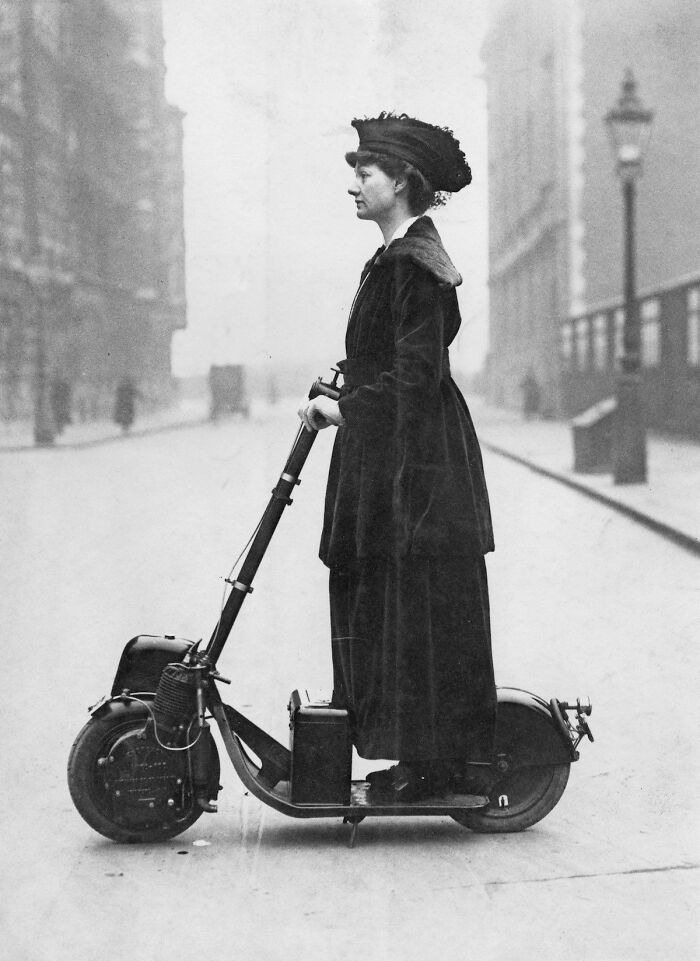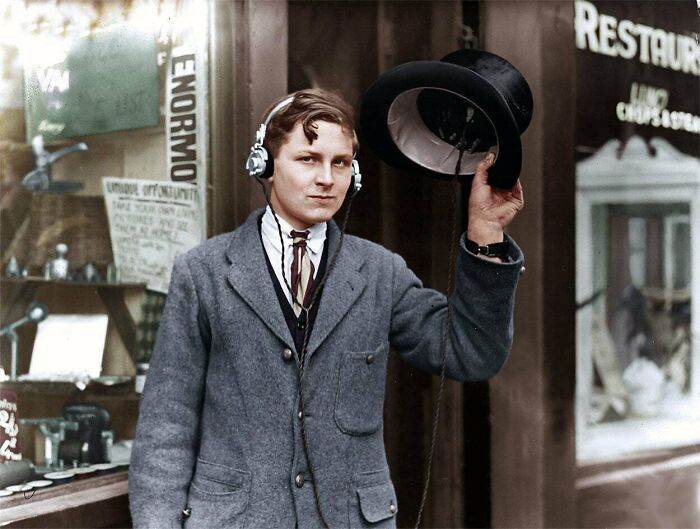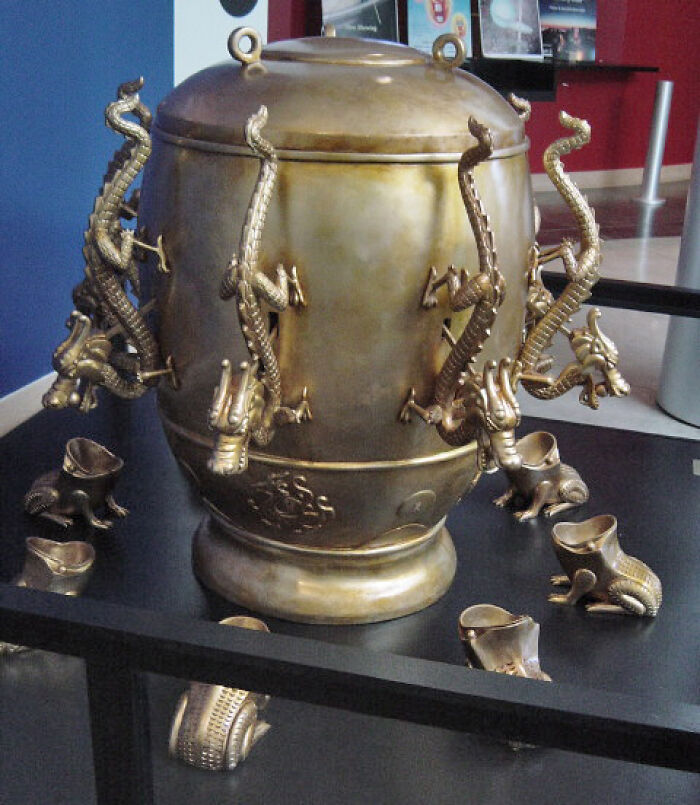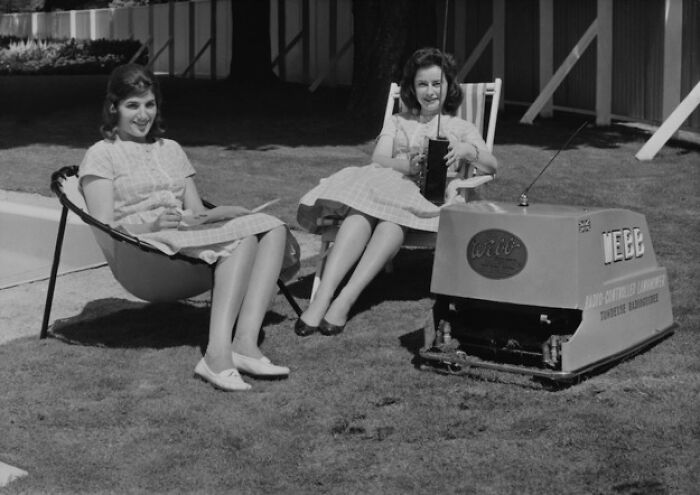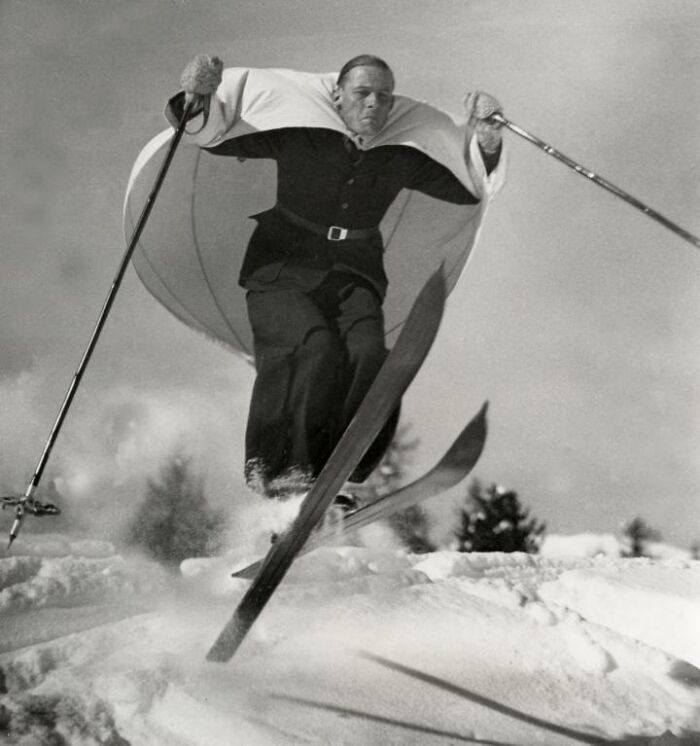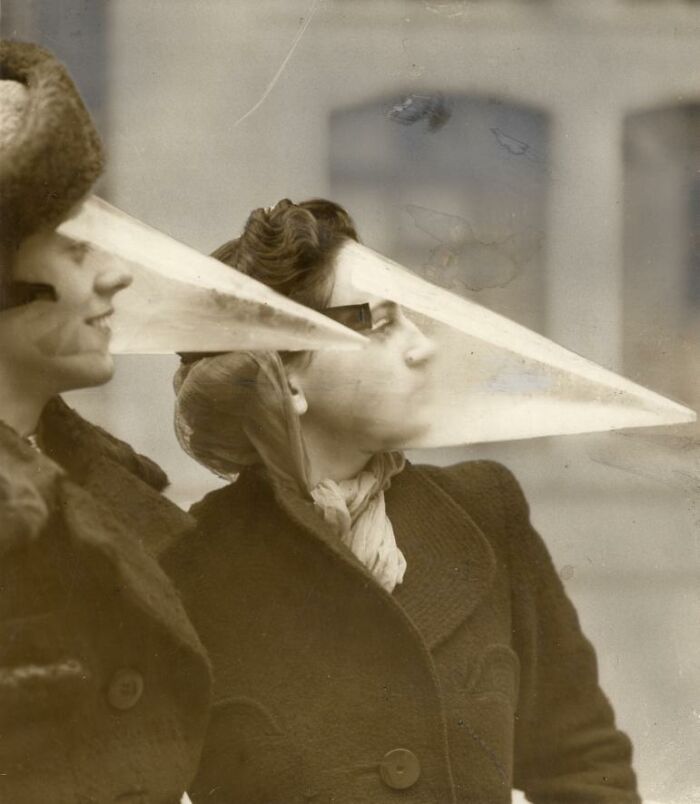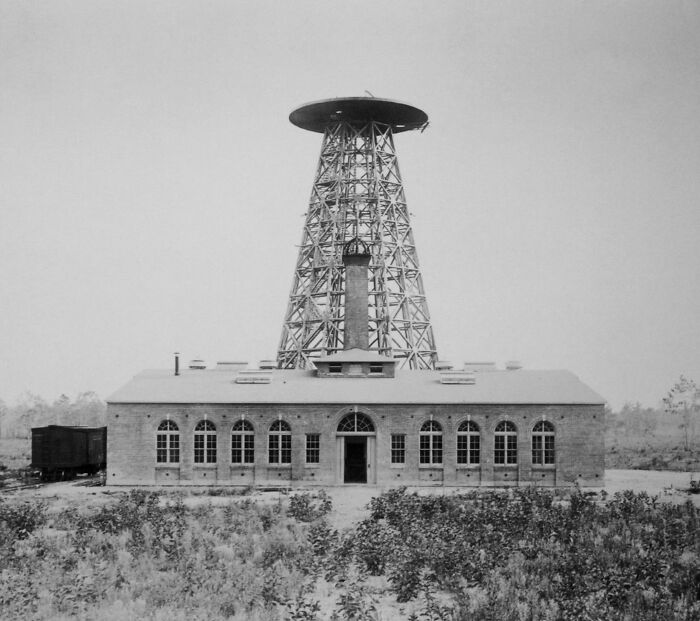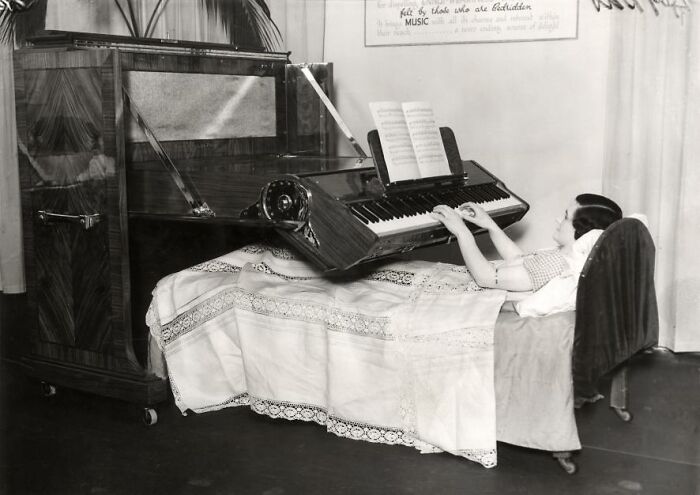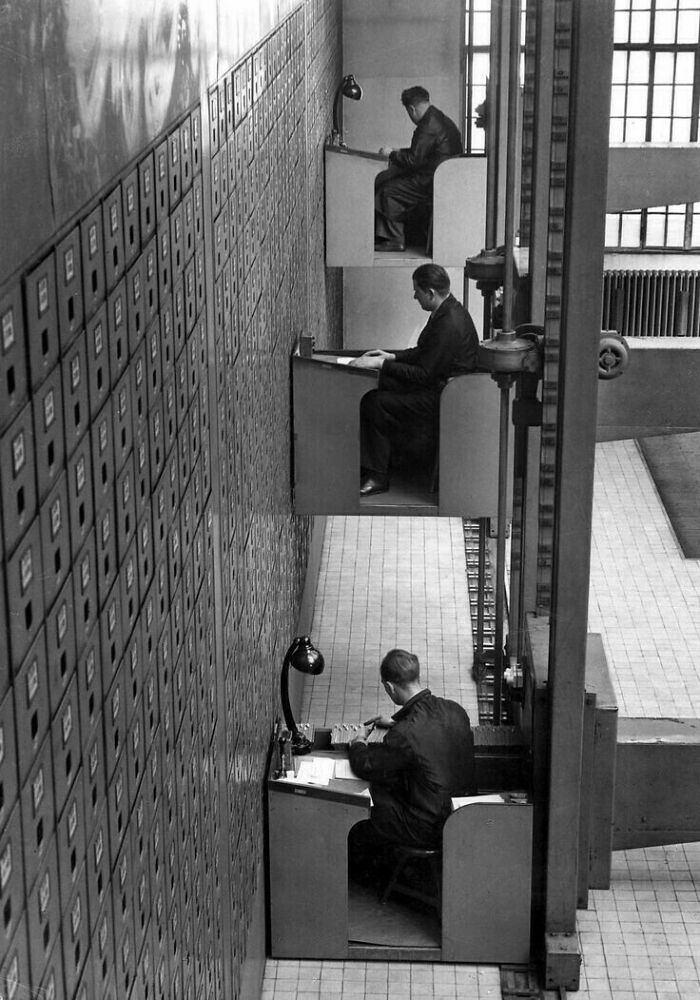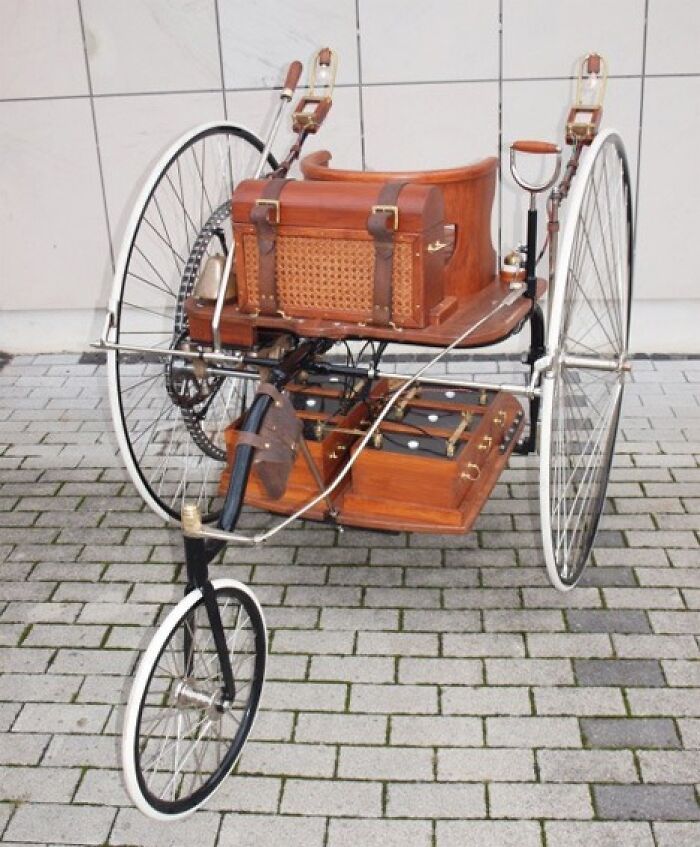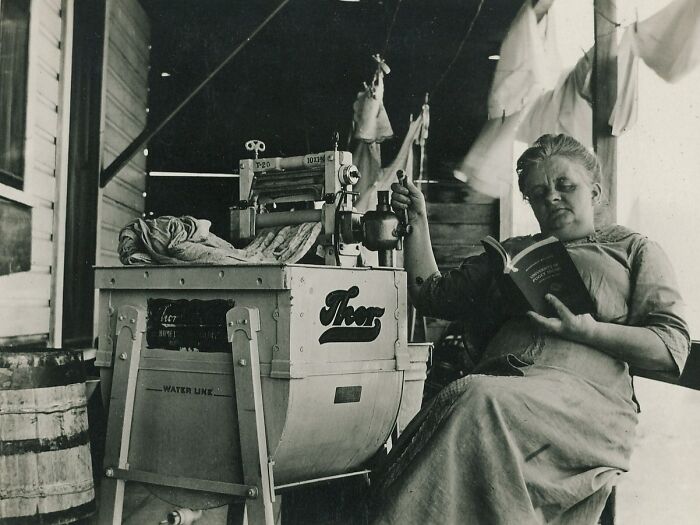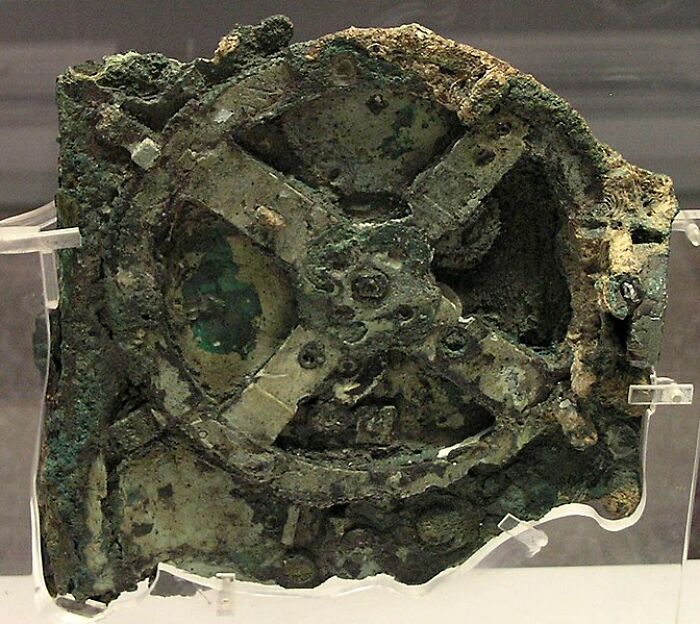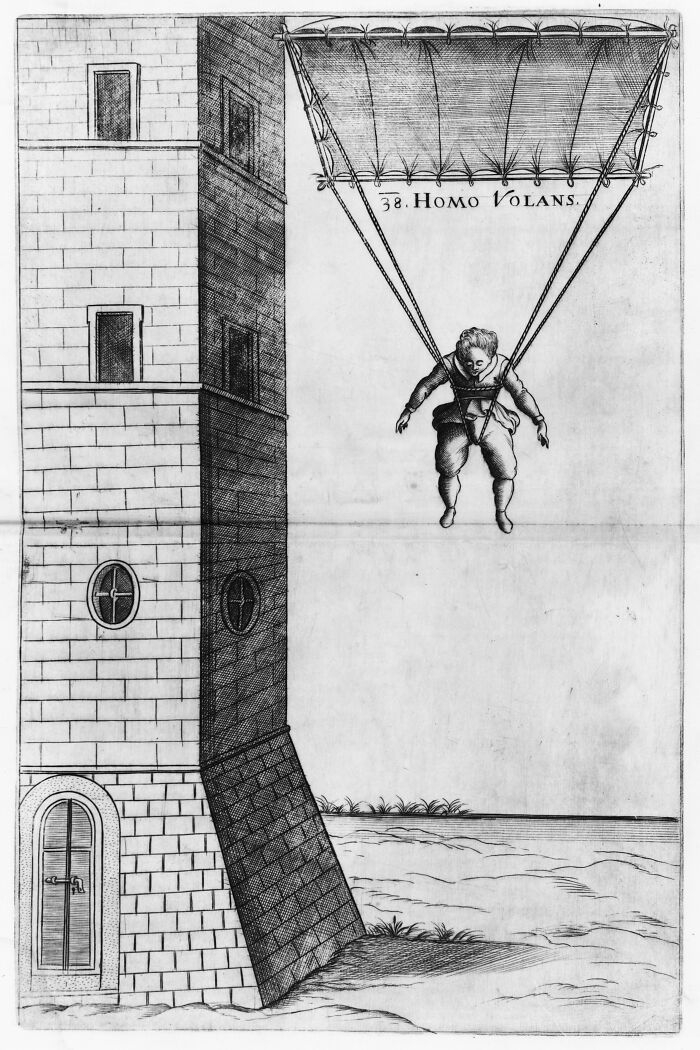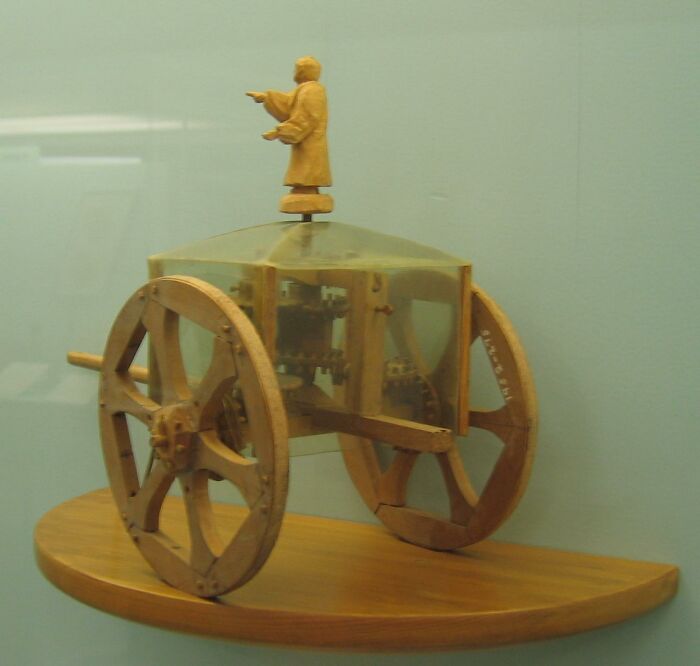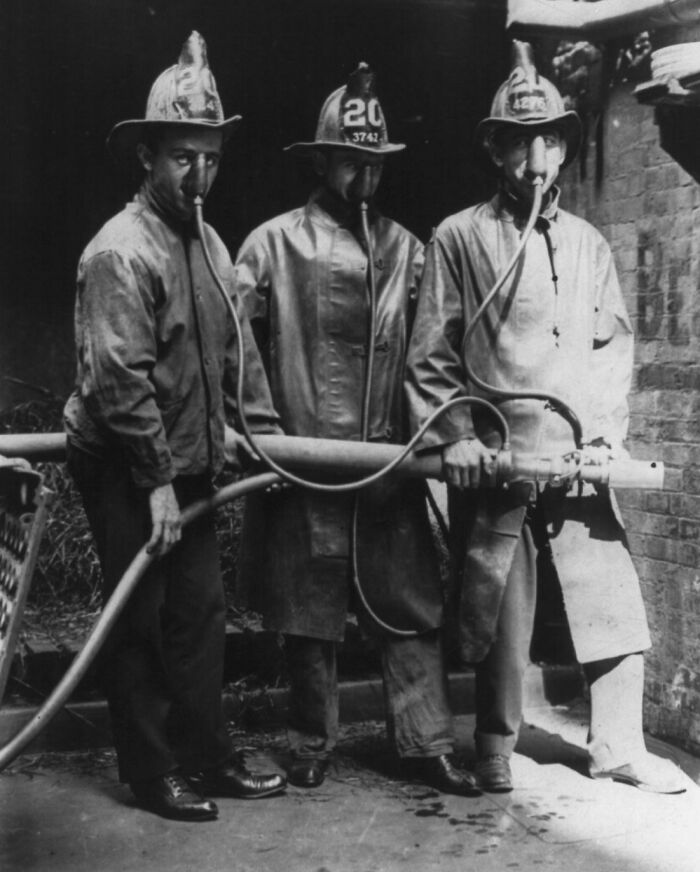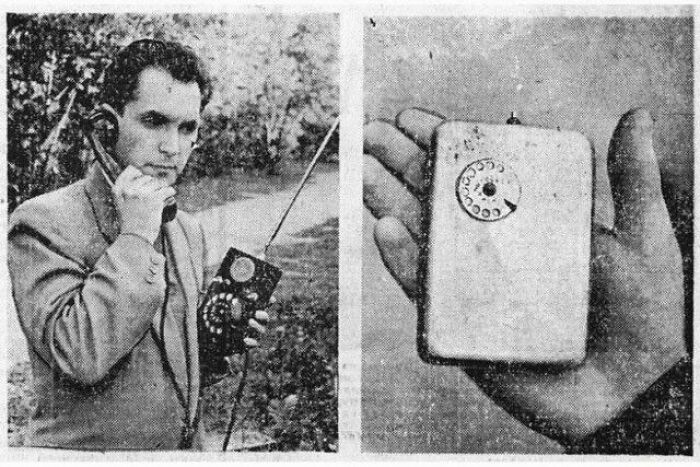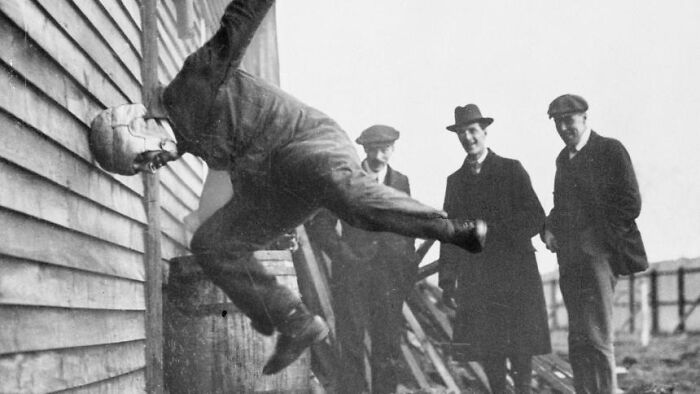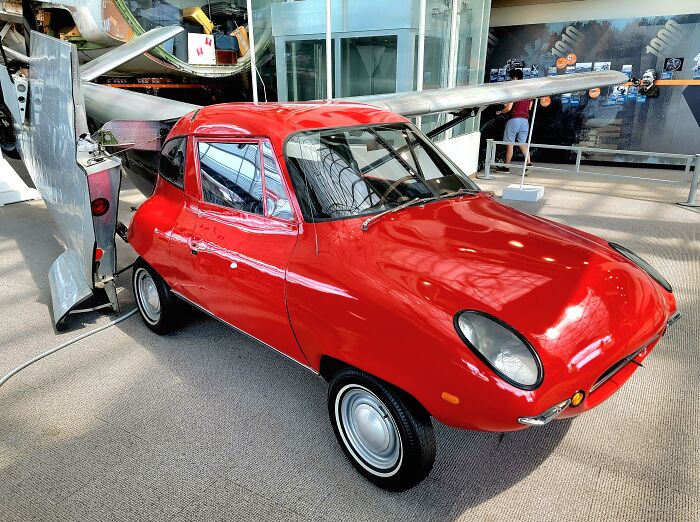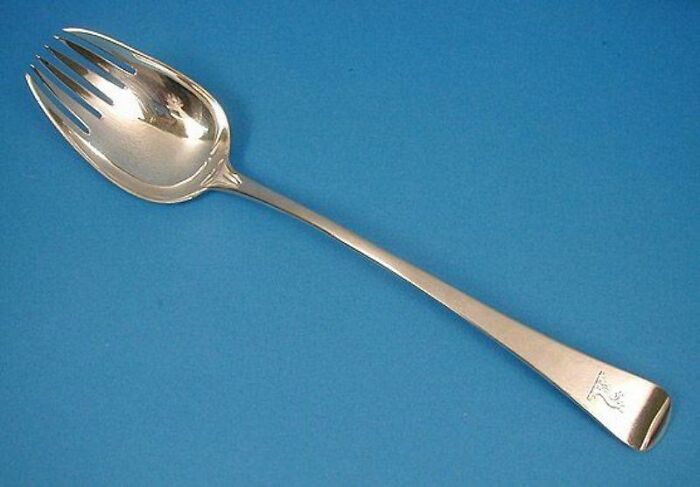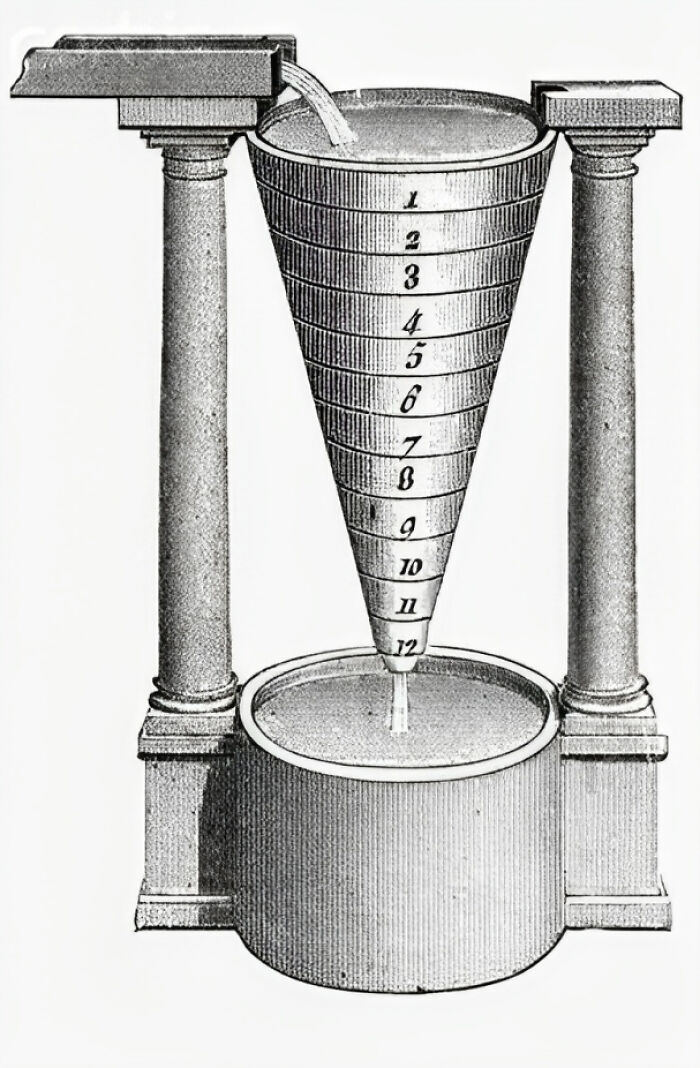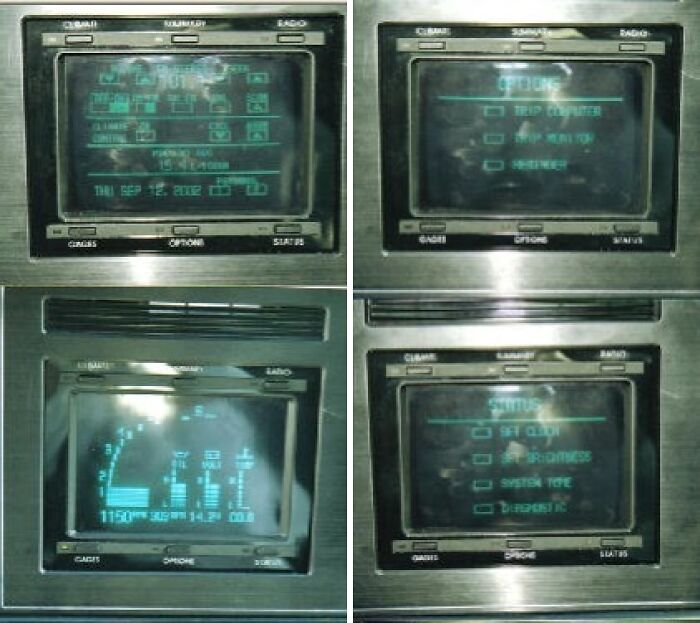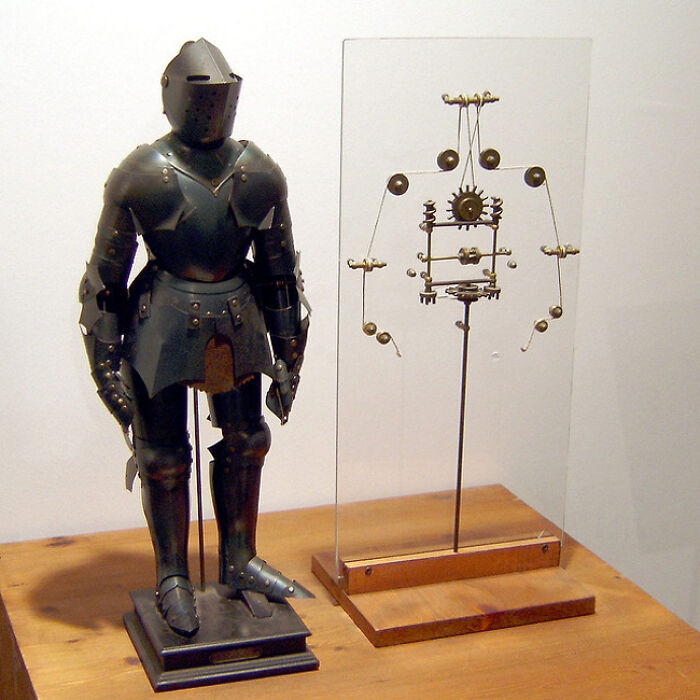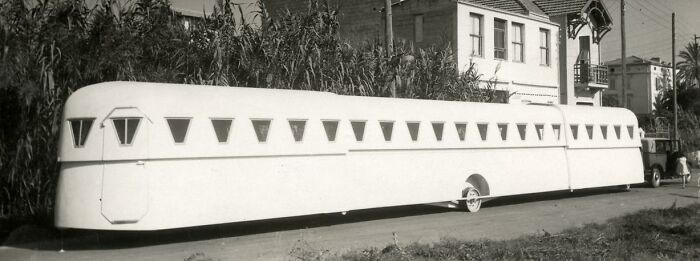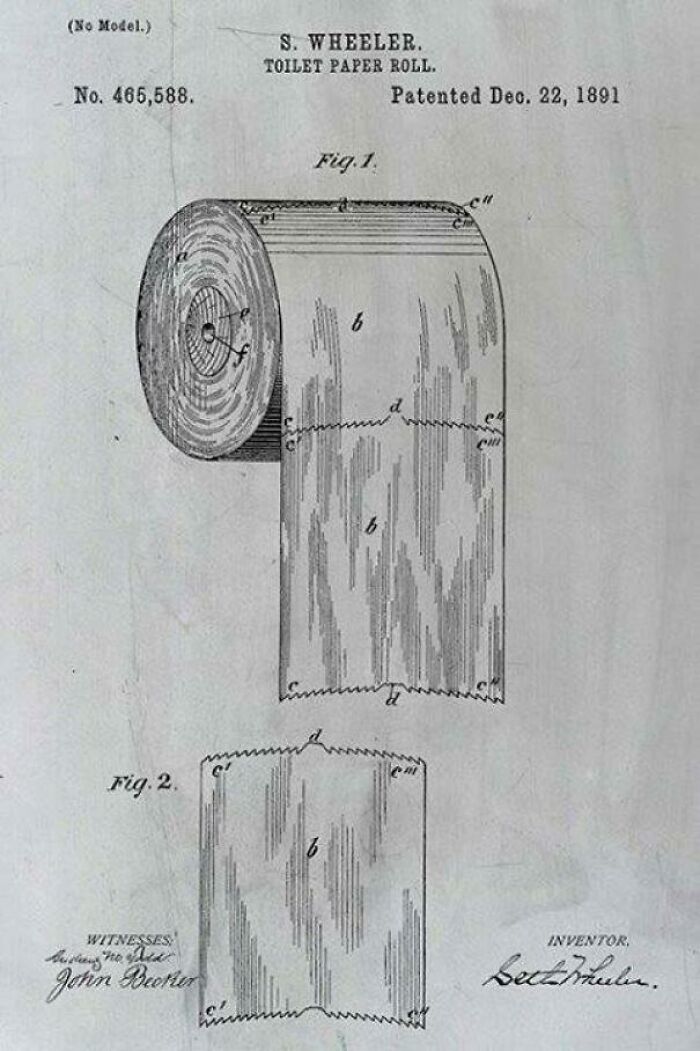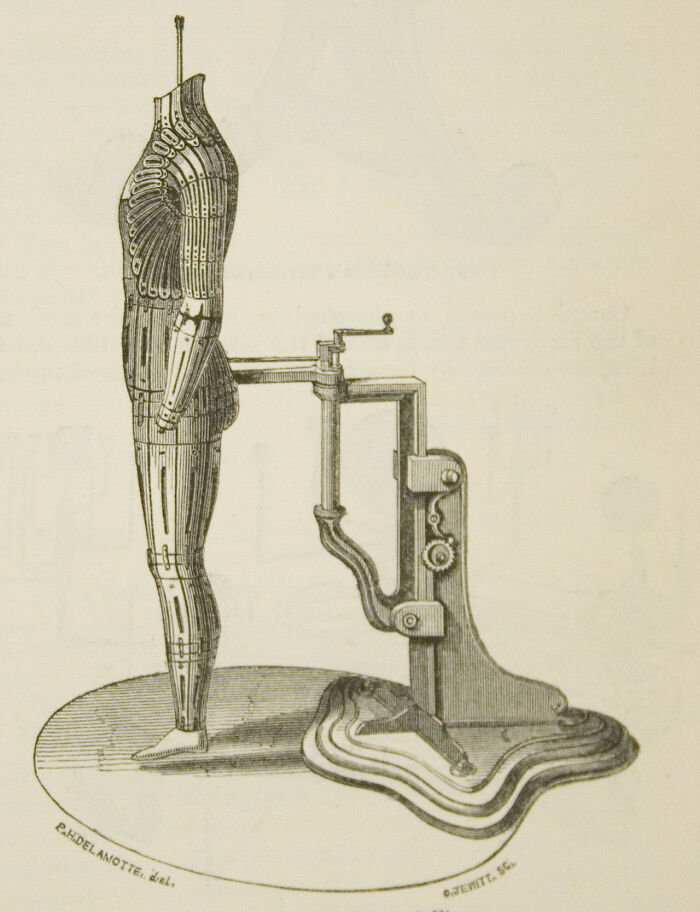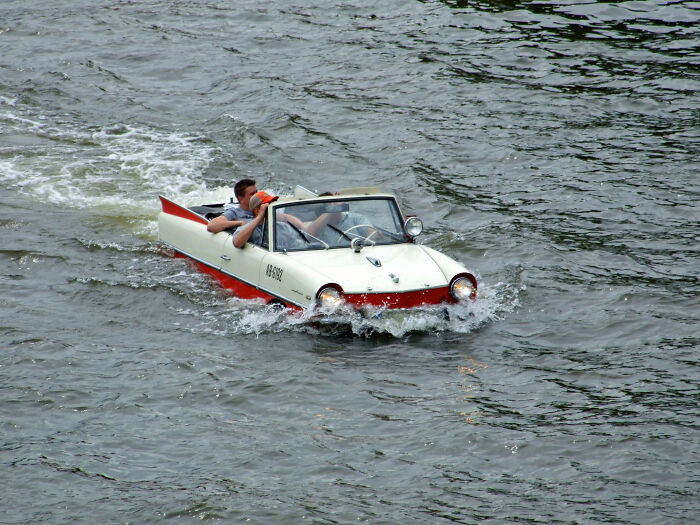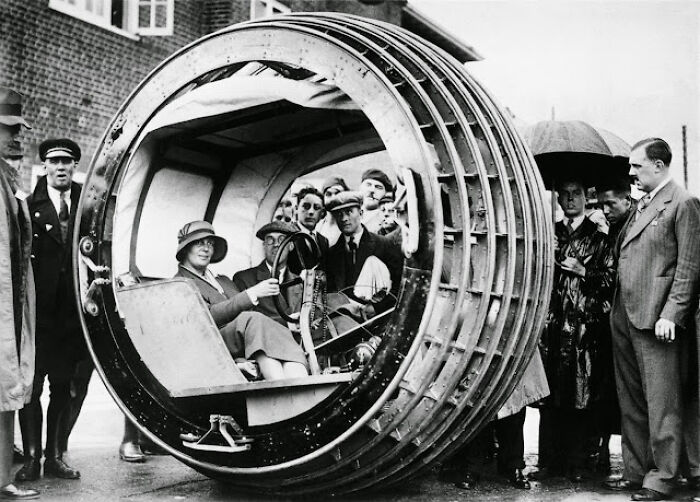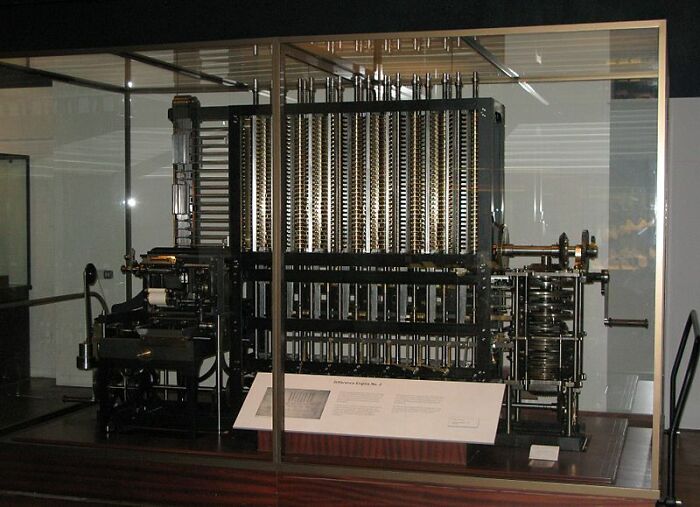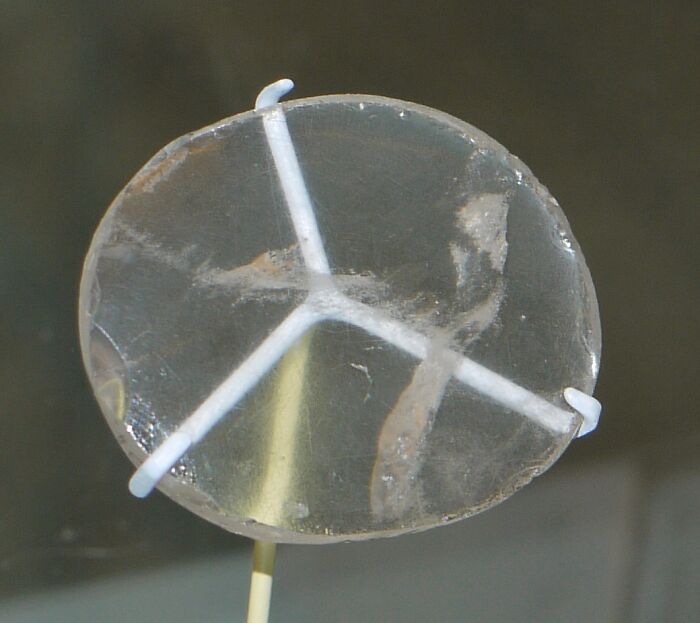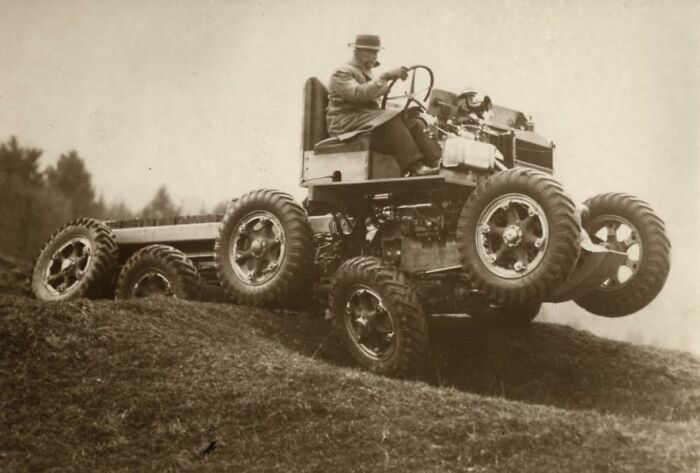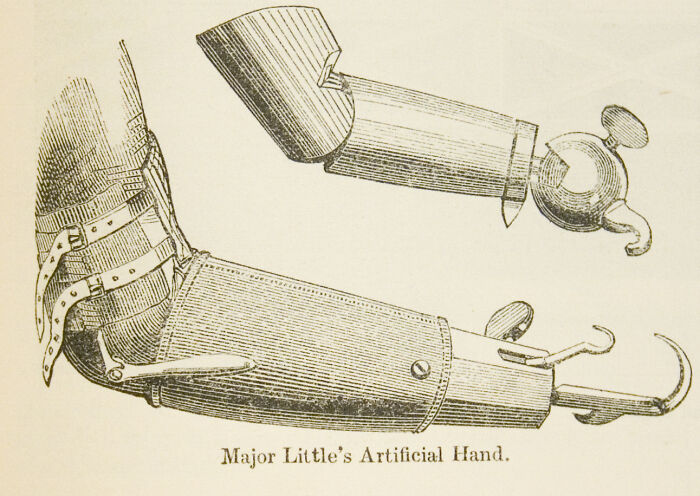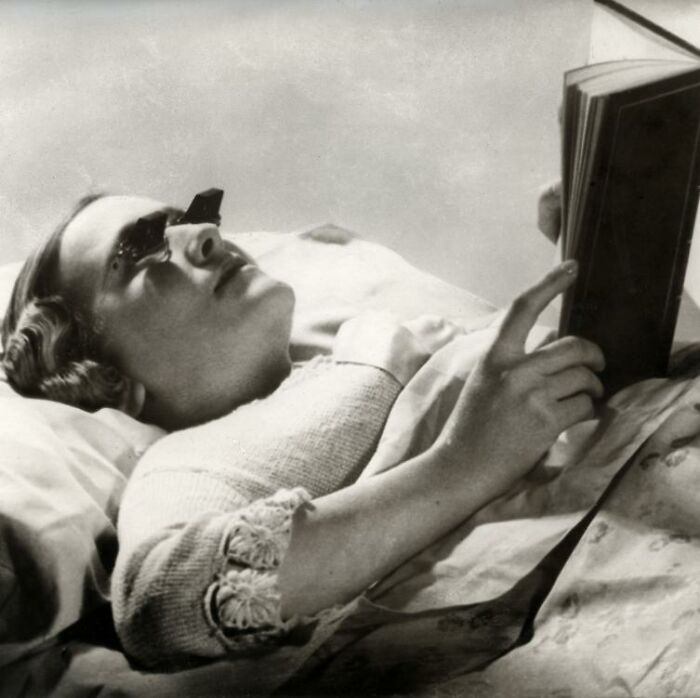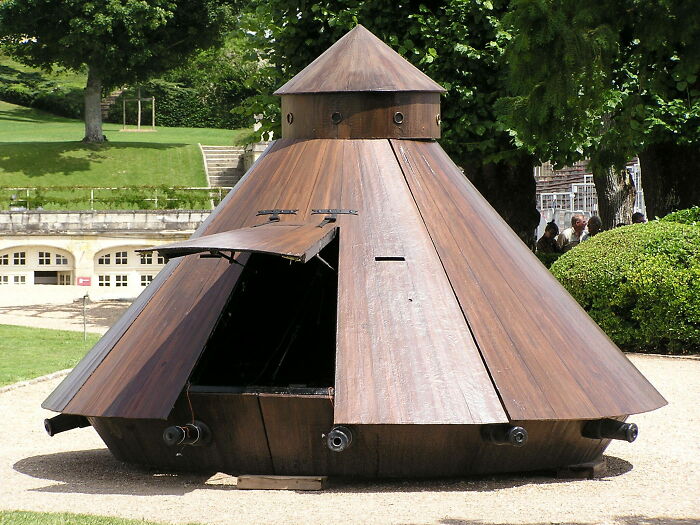When you think of a vending machine, things like snacks, sodas or even pharmaceutical supplies could come to mind. But you might be surprised to know that the first ever vending machine actually dispensed holy water. Yep, people back then would insert a coin and receive just the right amount of holy water from temples in Egypt.
While the vending machine might seem like a fairly modern invention, it’s actually believed to have been around since the first century. It’s one of many historical inventions that were way ahead of time. Bored Panda was intrigued to know what other creations have been around longer than we thought, so we took a deep dive down the passage of time to find out. From flying cars, to ancient earthquake detectors, and automated doors, it turns out the world has been filled with futuristic inventions far longer than we realized.
This post may include affiliate links.
An Early Motorised Scooter
The Autoped was an early vision of today's scooters. This was a personal transport system originally developed in 1915. It boasted a 155cc air-cooled engine and a top speed of 20 mph. This scooter was well ahead of its time and included some neat design features that wouldn't look out of place on a similar modern device. It came with both head and tail lamps, a horn and even a toolbox. It was also possible to fold the steering column down to make it easier to store.
The Autoped might well have come about as a necessity due to wartime fuel rationing but it wouldn't catch on at the time - not something that can be said now. Another design well ahead of its time.
18 Year Old Inventor, H. Day, Wearing Headphones Attached To A Wireless Device Under His Top Hat, May 1922
An Ancient Earthquake Detector
Today, seismologists use sensitive equipment to record tectonic movements deep within the earth and analyze this data to predict earthquakes. Although seismometers are becoming more advanced each year, accurately predicting earthquakes is still an inexact science. More than 2,000 years ago, however, an ancient Chinese inventor, Zhang Heng, made the world’s first seismoscope which proved to be incredibly accurate. Called the Houfeng Didong Yi, Zhang Heng’s seismoscope was made in the shape of ajar with eight tubes extended from a circle of dragon heads on the exterior of the jar. When the device detected an earthquake, a small ball fell out of one of the dragon’s mouths and into the mouth of a toad figure affixed to the base of the jar. The toad indicated the direction the seismic wave was traveling.
I had a random shower thought the other day... "Why do we say it's the best thing since sliced bread" when there have been so many more incredible and useful inventions since that bulky bread-cutting contraption was introduced to the world?
Seeing as I'm one who loves a good rabbit hole, I then ended up doing a deep dive into the origins of sliced bread. As it turns out, bread itself has been around for about 15,000 years.
According to scientists, our ancient ancestors were baking before they learned to farm properly. But it took thousands more years before humans were blessed with a machine that could cut perfect and equal slices of bread.
Vending Machines
Today’s vending machines are typically stocked with unhealthy snack options, like candy bars, sodas, and chips. The first vending machines, however, dispensed a product that was good for your soul. These vending machines from the 1st century dispensed holy water. Hero of Alexandria, a Greek engineer, mathematician, and inventor built a box with a series of levers. When the user inserted a coin, it triggered the levers to open a valve and pour out a small amount of holy water.
He invented so many things, like the sliding doors etc. There's actually a museum in Athens that has many "technological" inventions from the ancient world and half of them are by Hero of Alexandria!
The Microcar: Great For Small People And NYC Parking, Horrible In Any Other Situation
A Remote-Controlled Lawnmower
Correction. This is one of the first entrants to Robot Wars.
When we say "the best thing since sliced bread", we're going back to 6 July 1928. It was on this day that the very first automatically sliced commercial loaves of bread hit the shelves in the United States. It wasn't a baker or an engineer who invented the bread cutting machine, but rather a jeweler called Otto Rohwedder.
Ski-Sailing - A New Sport Invented In Austria, Demonstrated In St. Moritz, Switzerland
An Experimental Tracked Air Cushion Vehicle
In the mid-1960s to the late years of the 1970s, French engineers were looking to create new transportation machines that included the Aérotrain, an experimental Tracked Air Cushion Vehicle. This machine was essentially a hovertrain and a variation of the maglev train design. It was designed to ride on an air cushion above the track and thereby avoid all resistance in order to reach unprecedented top speeds. In 1969, a rocket-equipped prototype achieved a record speed of 262 mph.
The design faced numerous challenges not least of which was the need for elevated guideways wherever the train was set to travel. Sudden changes in wind pressure could also cause problems. The project was eventually scrapped due to a lack of funds.
Transatlantic Telegraph Cables
The United States and Great Britain were able to communicate electronically via undersea cable - in 1858! Before then, it took ten days to communicate between the continents by ship.
For reference, that's three years before the American Civil War. You know, when everyone still rode horses.
It's two years before Louis Pasteur proved that germs caused disease. That's right, we had trans-continental electronic communications BEFORE it was common knowledge that germs caused disease!
DEFINITELY ahead of its time.
Plastic Face Protection From Snowstorms. Canada, Montreal, 1939
Revolving Book Case, From Page 202 Of History And Description Of The Crystal Palace And The Exhibition Of The World's Industry In 1851
This piece of furniture certainly looks interesting. However, an upright bookshelf could fit the same number of books, take up much less space, and not require muscles to operate. Presumably, the appeal of a revolving book case is its novelty and design, in which case this one fits the bill.
Wireless Electricity
You know how we get radio, cell service, wi-fi, and television from signals that are broadcast through the air? Back in the early 1900s, genius inventor Nikola Tesla envisioned a system that would transmit electricity wirelessly through the air … free for anyone to use. He did more than just envision it. He conducted experiments and built a prototype to demonstrate the feasibility of his plan. Tesla’s Wardenclyffe Tower, located in Shoreham, New York, was supposed to provide free, wireless electricity, however Tesla ran out of money. He was unable to secure funds to bring his idea to fruition.
Piano Especially Designed For People Who Are Confined To Bed. Great-Brittain, 1935
Why It's Called "Moving Up" In The Company. Electric Elevator Desks In Prague, 1937
Television Goggles
In 1963, avid inventor and tech enthusiast Hugo Gernsback was photographed by Life Magazine showing off his "teleyeglasses" - a precursor to modern head-mounted displays.
Apparently, the idea of television eyeglasses came to the inventor in 1936, but it wasn't until the 1960s that advancements in tech made his vision possible. The television goggles used small cathode-ray tubes for the display and included a separate screen for each eye, much like modern VR headsets. The large antenna made this device look alien-like and it was certainly well before its time.
Sitting too close to the tv screen will ruin your eyes I was told as a child.
A Working Replica Of The First Practical Electric Car From 1881
Smell-O-Vision
To enhance TV watching and create a more immersive experience for viewers, television manufacturers of the early 1960s dabbled in Smell-O-Vision. As the name implies, Smell-O-Vision sought to synchronize specific scents to the content being displayed on the screen. While Smell-O-Vision generated interest and curiosity, it faced too many challenges to make it marketable. TV sets had to come fully stocked with a wide range of scents. Customers complained that smells lingered or caused allergic reactions. And some were, in the words of Spongebob Squarepants, “smelly smells that smells smelly.”
"Let's watch this programme about farming" Cue manure smells throughout the house.
La Decuplette, Bicycle For Multiple People, 1898
Housewife Doing Laundry Using The First Electric Washing Machine - Eatonville Wa C. 1910
The Antikythera Mechanism
In 1901, sponge divers found a strange device off the coast of the Greek island of Antikythera in the Aegean Sea. The device is a wooden box with a complex system of gears and a hand crank. Analysis on the device showed that it dates back to the 1st or 2nd centuries BCE. As out-of-place as it seems, the Antikythera Mechanism is an ancient analogue computer that predates Apple Computers by centuries. Most experts believe that the Antikythera Mechanism was used to predict astronomical positions, like eclipses.
Archimedes’ Screw
Designed by Archimedes, this device lifted water for irrigation. Its simple yet effective mechanism is still used in modern engineering for moving water and materials.
Parachute
Leonardo da Vinci sketched a parachute design in the margin of his sketch book with the following text:
If a man is provided with a length of gummed linen cloth with a length of 12 yards on each side and 12 yards high, he can jump from any great height whatsoever without injury.
In 1617, the first successful parachute jump was made from a tower in Venice.
Ok,I need to know something. Did the first person to try a parachute lose a bet, or were they very pįssed?
Chariot With Navigation System
In our times, a car with a navigation system is nothing surprising. However, when 2,000 years ago, during the Three Kingdoms period, the Chinese inventor Ma Jun created a chariot with a built-in compass for Emperor Ming-di, it was a real wonder.
There was no magnetic compass in the inventor's creation, so he had to come up with an alternative. On the chariot's roof, he attached an arrow, which, through a complex system of gears, could always point in one direction.
At the beginning of the journey, when the cardinal directions were precisely known, it would be oriented to the south. Then the chariot would move, and every time it turned, the mechanism rotated the arrow to ensure it always pointed in the designated direction. It was purely mechanical with no magnetic compass - the Chinese began using those only in the 11th century.
To create such a device, Ma Jun had to invent a differential gear and a reduction mechanism. According to historical records, these navigational chariots were used until the year 1300 and were essential for long journeys and reconnaissance expeditions.
Automated Doors
Automated door technology appeared in 1931 and was considered one of the signs of the “modern” age. Yet, the world had already seen this technology back in 1 AD. So how did it work? If you wanted to open the door, a fire would need to be lit to generate heat, causing an atmospheric build-up in brass vessels. This vessel would then pump water in holding containers, and these functions would act as weights to open the door. Think of it as a hydraulic system. Unfortunately, the doors were not that practical and not as popular as the modern doors you have around your city. The ancient doors took hours to open, and the process was hard to stop once it started. So, this probably meant that you only opened your doors once a day.
Engine Company No. 20 Of New York Shows Off The New Smoke Masks Invented By James D. Halloran, A Fellow Firefighter. October 18th 1911
Altai, The First Mobile Telephone, Created In Russia In 1963. It Allowed The Mobile Units To Connect To Landline Phones, And Was Originally Used For Emergency Services
Warren Safety Helmet, 1912
Flying Cars
Although we now have drones that deliver our pizzas and Amazon packages, the public is still waiting for the day when we can all zip around in flying cars like George Jetson. The concept of flying cars has been a longstanding vision of the future … and the first flying cars were invented in the 1950s. Perhaps the most famous flying car prototype was the Aerocar. Designed by Molt Taylor, the Aerocar was a road-worthy aircraft with foldable wings and a detachable tail section. In theory at least, it was supposed to easily convert from a small airplane to a car. The Aerocar fell victim to practical challenges, safety concerns, and FAA regulations.
The Runcible Spoon
No doubt, the spork – half fork, half spoon – has revolutionized the cafeteria and take-out experience for the last couple generations. The 16th century invention, the Runcible Spoon, outshined the spork even though it failed to become the newest, trendiest dining utensil. Textual references to the Runcible Spoon tell us that this utensil combined the fork, spoon, and knife into one handy tool for cutting, jabbing, and slurping one’s dinner. Some descriptions of the Runcible Spoon remind us of a grapefruit spoon because it had a sharp, serrated edge along one or both sides of the spoon. Why didn’t the Runcible Spoon take off? No one can say for sure, but it could be that the utensil caused injuries.
Water Clocks
Remember that Jim Croce song about saving “time in a bottle?” The Ancient Greeks had something like this centuries before 1973. One of the earliest types of timekeeping device, the Ancient Greek clepsydra used the flow of water to measure the passage of time. Clepsydras used either intake or outtake methods … water filling a container or water emptying from a container … to measure time. Unfortunately, clepsydras were not portable. In fact, disturbing the clocks in any way messed up the timekeeping.
Fun fact, clepsydra (κλεψύδρα in greek) comes from clevo (κλέβω) which means steal and hydor (ύδωρ) which means water.
1989 Buick Riviera
A few years ago I had an 89 Buick Riviera with a touchscreen computer. You could monitor fluid levels, have it greet you on your birthday, adjust the radio station, all kinds of stuff. It wasn't perfect, but the green text on the black screen was really cool. I've never had a car before or since that had a built-in computer.
Da Vinci’s Mechanical Knight
Robot based on Leonardo da Vinci's drawing: Leonardo da Vinci was not only an artist and painter, but he was a master of every branch of studies including human anatomy, mathematics and engineering. This robot was built based on a drawing by Leonardo, who can be credited with having a vision far into the future. Robots were unheard of at his times, and also beyond human imagination.
Central Heat
The Greeks did not have central heat in the same way that we have it today, but they were undoubtedly pioneers in the field of keeping homes warm. The system that was utilized by the ancient Greeks was first found in the Temple of Ephesus in 350 BC. The Ancient Greeks termed this as hypocaust which means “under burnt.”
While the Temple of Ephesus was the earliest building known to have this method of central heating, Vitruvius attributed the invention of central heating to Sergiu Orata in 80 BC. The practice remained in use up through Ancient Rome. In Ancient Rome, it was found in hot baths and public buildings, and in the homes of the very wealthy because of the high cost.
The hypocaust was created by making a structure under the floor of the building. The floor of the building would be raised up on pillars called pilae stacks. These pillars would have a layer of tiles above them which would be covered by a layer of concrete and then the floor tiles used for the building. A furnace would be lit and it would feed hot air and smoke into the space between the ground and floor of the building. The hot air and smoke would then rise through the clay or tile flues that made up the walls of the building before traveling out through outlets in the roof. In this way, the system could also be used to heat multiple floors of a building.
The system was very labor intensive and expensive to maintain. There would be need to have a slave or a laborer to constantly maintain the fire to just the right level for the comfort of the people within the building. There were also designs of bronze ventilators which could be used to regulate the temperature.
Extensible Caravan, Built By A French Engineer. France, 1934
Motorola Vice President John F. Mitchell Showing Off The Dynatac Portable Radio Telephone In New York City In 1973
The Debate Is Finally Over - Inventors Notes 1891
Amazing Invention From True Detective, March 1938
Adjustable Mannequin, From Page 433 Of Official Descriptive And Illustrated Catalogue Of The Great Exhibition 1851
The fact that something invented over 150 years ago can still seem ingenious is impressive. This mannequin, which can adjust to be just about any size a human can be, is an example of such an invention. Although it does look a little funny, the real oddity of this device is that it hasn't gained popularity yet.
These are especially useful to tailors and clothing designers. I have seen a few of the female versions in acquaintances' homes and shops.
Butter Sticks
Ok, so this one might not be as clever or forward-thinking as some of the other inventions on our list, but there's no denying its greatness. Why isn't this a thing? Probably due to the uproar against disposable plastics polluting the planet. Still, there's always Avocado Stick to sustain us.
Amphicar
President Lyndon B. Johnson, a practical joker, owned an Amphicar … an automobile that could float on water and be piloted like a boat. He loved to take guests for a ride around his Texas ranch then drive headlong into a lake. While his guests screamed and white-knuckled the dashboard, Johnson would shout about faulty brakes. The joke was on the unwitting victims. Johnson was one of the few proponents of the Amphicar, which was manufactured from 1961 to 1968 in West Germany. Demand for amphibious cars was limited. The Amphicar was discontinued, and the concept was relocated to Hollywood spy flicks and superhero movies.
I remember reading about this in a magazine when I was young, then saw one driving on the road of my hometown of Flint, Michigan, until then I didn't realize that it was real. The only one I ever saw.
The Dynasphere
Why drive on four wheels where you can drive on one? In the early 1930s, Scottish engineer J.A. Purves created a zany monowheel vehicle called the Dynasphere. Purves viewed the monowheel as an alternative to traditional automobiles like the Model-T Ford. Imagine sitting inside a giant tire that rotates around you. That’s how the Dynasphere worked. Only the Dynasphere didn’t really work like it was supposed to. The vehicle has issues with stability and maneuverability. It looks like a clown car. No wonder it failed.
Roman Concrete
Roman concrete, or opus caementicium, incorporated volcanic ash, making it incredibly durable. Structures like the Pantheon and aqueducts stand as testaments to its strength.
Only recently have modern scientists figured out the formula for Roman concrete. More modern formulas deteriorate fairly quickly, within decades. Whereas the structures made with the Roman formula have lasted thousands of years.
Difference Engine
Though one was never built in his lifetime, Charles Babbage proposed his idea for a difference engine, a kind of minimalist steampunk take on what a computer should do.
His ideas helped lay the foundation for the personal computers we have today.
The Assyrian Nimrud Lens
The Nimrud lens, a 3,000-year-old rock crystal discovered in 1850 at the Assyrian palace of Nimrud, is a fascinating ancient artifact. Roughly oval and with a focal length of 12 cm, it functions as a 3× magnifying glass, though its exact use is debated. Some believe it was a magnifying glass or burning-glass, while Italian scholar Giovanni Pettinato proposed it could have been part of an early telescope. This challenges the conventional belief that the telescope was invented by Hans Lippershey in 1608, suggesting that ancient civilizations may have had advanced knowledge of astronomy.
All Terrain Car Able To Descend Slopes Up To 65 Degrees
Gave way to the tracked vehicle commonly referred to as Caterpillar invented around 1910. Which formed the base for the tank
Hunter S. Thompson Using A Selfie Stick, 1957
A German Officer And An Nco Wearing Portable Sound Locating Apparatus’s To Detect Enemy Aircraft (This Was A Type Of Early Radar). Western Front, 1917
Artificial Hand, From Page 431 Of Official Descriptive And Illustrated Catalogue Of The Great Exhibition 1851
Major Little should have gotten a patent on this idea. Now everyone thinks it was Captain Hook's, although he wasn't even imagined until over 50 years later.
An Ergonomic Workstation From The 1970s
Back in the days before the modern PC and fancy-standing workstations, designers were still managing to come up with weird and wonderful seating arrangements for workers.
This vision of the future included an all-in-one design with a figure-hugging chair, a built-in typewriter and even some earphones with extendable aerials. A vision of tech luxury for the time, but perhaps a step too far?
Greek Fire
The Greeks created an incendiary weapon that was lit. Literally lit. Between the 7th and 12th century, the military of the Byzantine Empire had a secret weapon that made them virtually unbeatable in naval battles. That weapon was called Greek Fire. What was Greek Fire? We don’t know. The Greeks kept the formula a closely guarded secret … so secret that it has been lost to time. Greek Fire was described as “burning on water.” It was probably made of petroleum, quicklime, or other flammable chemicals that would float on the surface of the water as it burned.
Video Phone
Facebook logged over 17 billion video calls in 2017 and Skype was reported to have 300 million active monthly users in the same year. Add this to Apple FaceTime, Google Hangouts and all the other video calling and conferencing software that is being used and you have some very large numbers. They would no doubt totally impress and perplex the makers of the AT&T Picturephone which had its first public unveiling in 1964 at their exhibit at Disneyland California. The company tried and failed to launch the product again and again throughout the rest of the century putting it down to the product being too intrusive, expensive and not good enough quality. As webcams started to become mainstream on computers we found that the ease of use and price were big factors in the original shortcomings of the video phone but actually that people were not afraid to be seen.
Pigeon Drone On A Steam Engine
In 428 BC, in Greece, an outstanding inventor, mathematician, and physicist of antiquity was born - Archytas of Tarentum. His research on the propagation of sound in the environment led to the creation of the first theory of acoustics in history. Archytas also developed schematics - a method of transmitting images of a working mechanism using geometric figures. However, the most famous of his inventions was the wooden pigeon that could fly. This device was hollow, and had two large wings in the middle, and two smaller ones at the back, resembling tail stabilizers. The rear part of the pigeon had an opening connected to a leather bag placed in the body.
The process of using the device involved placing the bird on a boiling cauldron, after which steam was pumped inside until the pigeon took off. Chroniclers claimed that the apparatus could fly a distance equivalent to several hundred meters.
Talking Doll
Thomas Edison invented the cylindrical phonograph in 1877 and was looking for ways to commercialize it. In 1888, Edison developed a china doll equipped with a cylindrical phonograph with pre-recorded messages. It was a commercial flop — consumers thought the dolls were creepy.
Talking dolls did not enjoy commercial success until 1959 with Mattel's Chatty Cathy. Chatty Cathy could say 11 phrases and was the second most popular doll of 1960 (after Barbie)
A “Road Safety Machine” To Train Motorcyclists. Otherwise Known As Your Grandfather’s Arcade Game
“Foot Tickling Machines.” The Purpose Of Which Remains Unclear Other Than Sheer Amusement And To Say You Tried It
Hamblin Glasses. A Pair Of Spectacles Especially Designed For Reading In Bed. England, 1936
Loetafoon - Gramophone Record Player That Is Connected To A Film Projector. A Mercury Contact On The Film Indicates Exactly When The Needle Should Be On The Record To Start The Sound Film. The Device Is Supplied With A Single, Double And Triple Turntable
Tide Mill. The Left Lock Lets The Water In From The Spout Basin, The Right Lock Lets It Flow To The Sea. Ijsbrandt Jansz, 1598
An Unusual Aerodynamic Motorbike
At the 2008 Paris Motor Show, this concept vehicle was unveiled. A quirky aerodynamic motorbike design with the driver laying down and essentially holding onto the front wheel.
It looked like something inspired by Tron and would never catch on. But there's no denying the design is likely well beyond its time. It also no doubt makes for a terrifyingly thrilling ride.
Leonardo Da Vinci's Tank
Leonardo da Vinci is well known for his various talents that included painting, sculpting, astronomy, botany and cartography as well as a flair for the sciences. He was also an inventor who crafted or conceptualised a multitude of designs for tech well beyond its time. Some of these concepts included things like the parachute and an early helicopter. Considering he was doing this back in the 16th century (he was born in April 1452) it was a staggering feat indeed. One of these visions of future tech included a fighting vehicle that was essentially a modern tank inspired by a turtle's shell. The design for this tank included a call for reinforced metal plates to protect the occupants, slanting sides to deflect enemy fire and an array of light cannons. It could barely be built at the time, but was an interesting vision of the future of warfare.
The Baghdad Batteries
A number of strange ceramic jars, dating back to around 250 BCE to 224 CE, near Baghdad, Iraq. The jars contained copper cylinders and an iron rod. Archaeologists were puzzled. What could these jars be? When filled with an acidic liquid, like wine or vinegar, the jars produced electricity. In the 1930s, a German archaeologist, Wilhelm Konig, dubbed these Baghdad Batteries. Did people in antiquity need batteries to charge their cell phones or power their boomboxes? Of course not! The most common theory is that Baghdad Batteries were used to electroplate objects.
Actually no, that is not the most common theory. No electroplated objects were ever found anywhere in the Sassanid empire. No wires either. They did however unearth some nearly identical jars very close to where these were found. Their purpose was to hold papyrus scrolls, wound around the iron rod and placed inside the copper cylinder. It was then sealed with an asphalt like substance.
The Aeolipile
In the 1st century AD, a Greek engineer and mathematician, Heron of Alexandria, invented the first steam turbine. Called the Aeolipile, or Heron’s ball, this device consisted of a simple hollow sphere mounted on a central axis. The sphere has two curved nozzles pointing in opposite directions, each positioned on opposite sides of the sphere’s equator. When the sphere is filled with water and heated, the water vapor escapes through the nozzles, resulting in a rotational motion of the sphere. Heron’s aeolipile is considered an early demonstration of the principles of steam power, although its practical applications were limited in ancient times.
Microsoft Tablet
Who knew that Microsoft actually invented the tablet a decade before Apple? At the turn of the century, Bill Gates predicted that his tablet would be “the most popular form of PC sold in America within five years” only for it to die soon after. The main issue was that Microsoft envisaged their tablet to replace the desktop as the customers’ main use computer. It was designed with the same operating system as a PC and had a price tag to match at around $2000. Apple came along later and designed their tablet with a different operating system, look and feel, realising that it couldn’t replace a laptop or computer, but would be an additional product. “He [Steve Jobs] did some things better than I did,” reflected Bill Gates. “His timing in terms of when it came out, the engineering work, just the package that was put together. The tablets we had done before, weren’t as thin, they weren’t as attractive.”
Ask Jeeves
The 1990s, when we were all doing The Macarena, trying to keep our Tamagotchis alive and, most incredibly, using multiple search engines. Shout out to Lycos, AltaVista, Yahoo and everyone’s favourite knowledgable cartoon butler, Jeeves. But despite leading the search engine race for a period in the late nineties by being the first to understand natural language queries, Ask Jeeves (or any of the others) could not compete with Google who won the race with its superior technology, user-experience and advertising model.
Google now holds an 89.1% market share according to Statista.com. Ask.com is still there, rebranded now as a “question and answer site” as opposed to a search engine, although we’re not really sure the difference.
Apple Newton Messagepad
It must be a relief for Bill Gates to see an Apple product feature on this list! Apple’s pocket-sized, handheld “personal digital assistant” (PDA) launched in 1993 and was able to take notes, store contacts and manage calendars. The device was an epic failure, largely down to being launched around a time where the company was in some turmoil. Steve Jobs was about to reclaim his position as CEO and the company had way too many projects on the go leading them to rush this product out, forgetting about the most important thing – the consumer. “We were just way ahead of the technology. We barely got it functioning by ’93 when we started shipping it.”
The Newton MessagePad lead the way for taking the computer out of the office and for Palm Pilot to later have more success with their handheld PDA which focused on the user. It was also the first time we’d seen technology that could take a sentence like “dinner with Anna tomorrow” and turn that into a calendar item, the way we do today with Siri.
Mithridate
Mithridatium, named for King Mithridates VI, was an alleged “universal antidote” to all poisons. Though the exact formula has been lost to time, historians believe it included opium, chopped vipers, and small amounts of both poisons and their antidotes. The antidote was developed around 100 B.C. and used for many centuries, especially in Italy and France. It was even used not long ago in 19th century under the name “theriac”. Today, the recipe is unknown but there have been documented attempts to recreate the formula to this miracle antidote as recently as the 1990s.
The Radio Hat
Folks in 1949 probably thought they were quite space-agey when they wore the “Man-From-Mars Radio Hats,” a basic bucket hat with a built-in radio. Thanks to advertising and promotional campaigns on popular radio shows around the country, radio hats were all the rage for a hot minute. Manufactured by the American Merri-Lei Corporation, a company that sold party supplies, radio hats predated the invention of transistor radios. Wearers walked around with vacuum tubes and antennae in their hats. And there were no headphones so wearers could more readily share their music with everyone around them, whether they liked it or not.
Telharmonium
Electronic music wasn’t a disco-era invention. The Telharmoniun, sometimes called the Dynamophone, was invented in the late 1800s by Thaddeus Cahill and is widely considered to be the first electronic musical instrument. Unlike the sleek electronic keyboards we are used to, the Telharmonium was a massive apparatus. It consisted of a series of spinning rotors and tone wheels that generated electrical signals to make sounds. The electrical signals were transmitted over telephone lines so listeners could listen to music via their phone receivers.
Sega Dreamcast
In 1999 everything looked so promising for the Sega Dreamcast – it was the first video console to offer online gameplay and interactive memory cards. It also had the biggest media launch to date. By 2001, sales had been discontinued and Sega was only to produce software from then on. The Dreamcast suffered terribly from piracy as PC users were at the same time learning how to burn their own CDs. The Dreamcast didn’t have any restrictions for ripping CD-R discs which were then sold on illegally much cheaper or put online. The final nail in the coffin for Sega was Sony announcing the release of the PlayStation 2. It was to have broadband online connectivity (the Dreamcast only offered dial-up), it was much faster with more memory and offered playback. While the Dreamcast sold 10 million units over two years, the PlayStation 2 sold 155 million units and it was 12 years before it was discontinued.
Still got mine. Still dig it out from time to time. Best console ever.
Flushing Toilets
A self flushing toilet and plumbing system in 1800 BC!? Yep, the Minoans had that in the bag 1000 years before Homer wrote his Odyssey. The Minoans were an advanced civilization which flourished around 4000 years ago on the island of Crete and preceded the civilisation we know as ‘ancient Greece’. A culturally rich people who prized innovation, the Minoans were found to have advanced plumbing knowledge which allowed them to have self flushing bathroom facilities thousands of years before ‘modern’ civilisation. The Minoans had an advanced drainage and early aqueduct system which brought fresh water from streams in to the city and allowed storm water and sewage to be drained into gardens outside the city. Ground level latrines with overhead water reservoirs to be tipped in to perform the flush abounded in the savvy city.
Design Of A Steam Automobile, Circa 1845
Washing-Machine With A Pump, Invented By E. Koers. The Netherlands, 'T Joppe, Gorsel, 1951
And the man is, of course, instructing the woman how to do her job correctly. How we men nobly sacrifice our time to help women.
Sort Of Tomtom, Early Tripmaster: Rolling Key Map. The Map Passes The Screen In A Tempo That Depends On The Speed Of The Car,1932
Tanks For Filtration Experiments, 1891 - 1892, Galvanized Iron Tanks On Right May Have Been Used For Sludge Digestion Studies
Coffeemaker, From Page 304 Of Official Descriptive And Illustrated Catalogue Of The Great Exhibition 1851
This clever coffee machine uses a double-rotation system to heat every part of the metal sphere, so your coffee is evenly roasted. However, it probably won't fit on the counter in your office's break room.
It's not really a coffee machine, just a roaster. Modern ones aren't so different, and some similar machines are still in use to this day. view-of-co...F2CM58.jpg 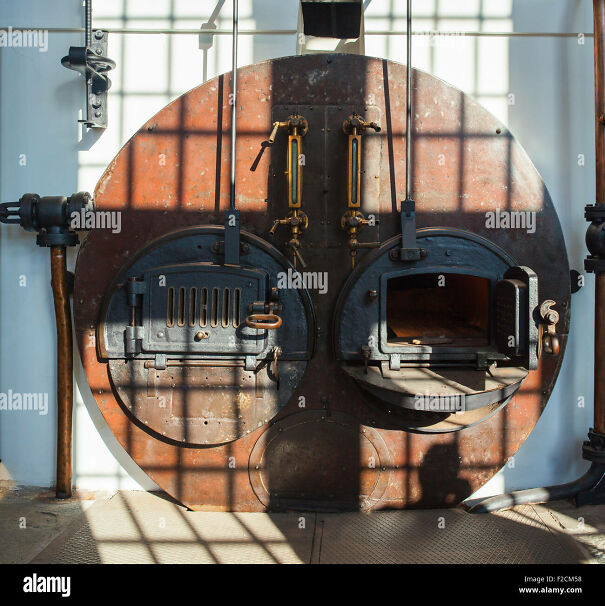
Sheep-Dipping Apparatus, From Page 371 Of Official Descriptive And Illustrated Catalogue Of The Great Exhibition 1851
At first glance, this picture appears humorous merely because it mentions dipping sheep. However, it turns out that sheep dipping was an important aspect of the lives of sheep farmers, and still is today. By dipping their sheep in vats of disinfectant, farmers could prevent parasites from spreading among their flocks and clean the sheep's wool in preparation for shearing. Still, it does look a little goofy.
Necessity Is The Mother Of Invention Ane Would Be Stuck In Mud For The Whole Evening If It Hadn't Been For This Smart Solution
Lower End Of The Flying Fox Wire For Sugar Cane Transport Over Bilambil Valley, N.s.w. - 1909
Anti-Comet Pills And Umbrellas
Astronomers figured out a long time ago that Halley’s Comet swings past Earth roughly every 75 years. Folks were eagerly awaiting the comet’s return in 1910 until astronomer Camille Flammarion announced that the comet would come so close to Earth that our planet would pass through the comet’s tail, exposing mankind to potentially toxic space chemicals. While most people panicked when they heard about this, get-rich-quick inventors saw it as an opportunity. They offered anti-comet pills, which they claimed contained antidotes to counteract the space chemicals. In addition, anti-comet umbrellas hit the market. These were basically regular umbrellas covered in tin foil. The gullible public bought both of these items, then breathed a sigh of relief when they “worked”.
Pre-1900 Punch Cards
Early, pre-1900 Punch-cards. While they appear simple at first. They are basically tiny bits of memory for purely mechanical computers.
They had nearly a kilobyte of 'data' on some of the larger punch-cards. They could have stored the data for some small modern-day jpegs on what's effectively just a piece of paper. That's pretty nuts.
Tin Can
The can. The can opener was invented 48 years after the invention of the can. How did people even open them?
Mattel Power Glove
An attempt at innovation on the Nintendo platform, albeit one designed by toymakers Mattel, was the ominous-sounding Power Glove.
The Power Glove was a 1989 device that could not have looked more like it was designed in 1989. Much like later (more successful) kinetic-based systems like the Wii, the Power Glove allowed the player to control movements within video games.
The Power Glove was based on another device called the Dataglove, which could detect yaw, pitch and roll, using fibre-optic sensors to detect finger flexure.
However, to make it affordable – it came in at $75 – all of this was scaled back to determine just the user’s roll of the hand within the confines of a sensor angled at 90 degrees.
Two games and 100,000 units later, and after just a year, it was decommissioned, but today much of this tech lies within our phones.
General Herman Haupt , Of The Union Army Holding Oar And Sitting On Raft Constructed Of A Pair Of Small Pontoons And Several Wooden Planks
Small Trouser Press, Shown At An Invention Fair In Westminster, England, 1936
Contact Lens
Contact lenses might seem like a modern invention, but these types of corrective vision devices can trace their roots back hundreds of years. Leonardo da Vinci, the famed artist and inventor, was the first one to float the idea of contact lenses. His 1508 Codex of the Eye described ways to alter the cornea to improve eyesight. In 1632, Rene Descartes revisited the idea of contact lenses. His idea involved tubes of water that would be stuck into the eyes and held in place with an external support system. Of course, the wearer couldn’t blink, but at least they could see.
Sony Minidiscs
In 2022, storing music is simple and done by millions of people every day. But before the advent of the iPod, Sony MiniDiscs were a preferred way of storing music as well as data in the '90s, a pricey gadget that was also well ahead of its time. A friend of mine bought the Sony MiniDisc (1992). It cost almost $800. But it was amazing. The idea of storing music on this little disc, and being able to add and delete songs? Just never took off.
Nintendo Virtual Boy
In 1995, 20 years before its emergence as a must-have technology for gamers, virtual reality (VR) reared its head, as Nintendo brought out its very own VR headset for the consumer market.
Or, at least, it was considered the first gaming device capable of playing games in ‘true’ 3D, which hadn’t even been attempted for home use before then.
Nintendo hadn’t gone into this venture half-heartedly. They had worked on a 3D, stereoscopic, head-tracking prototype called the Private Eye – the designs for which would go into developing the Virtual Boy – but limitations of technology at the time turned it into a stationary viewing device with a stand that looked, frankly, silly.
Given its limitations, its US and Japan only release, and the $179.95 price tag in the US, it might not come as a surprise that the device was a total flop, but you have to admire Nintendo’s attempt.
Willis Carrier, Class Of 1901, With His 1921 Centrifugal Chiller
Photo provided by the College of Engineering.
Air Turbo Head Massaging Machines
The First Mouse, 1964, National Museum Of American History Exhibit - Places Of Invention
Dr. Carter Moffat's Electric Belt With The Invention Of Electricity, All Manner Of 'Electric' Products Suddenly Appeared On The Market. From A Book By Peter J. Phillips
Soda-Water Machine, From Page 306 Of Official Descriptive And Illustrated Catalogue Of The Great Exhibition 1851
This fancy contraption can produce 300 to 400 dozen bottles of soda water per day! Imagine the amazement of the British people when they discovered that for the right amount of money, they could have a soda water machine that could fit in their parlor. It is also amazingly easy to use; according to the description, someone would have to crank the handle on the side for ten minutes and "when this is done, the bottling goes on without interruption."
Immense Wine Jar, From Page 150 Of History And Description Of The Crystal Palace And The Exhibition Of The World's Industry In 1851
In 1851, instead of "Blondes have more fun," the phrase should have been "Spaniards have more fun." Englishmen putting on the Great Exhibition admired the many great qualities of Spanish culture showcased, which unfortunately did not include Spanish women. In fact, on page 15 of this book, the authors wonder "Why have we not likewise in the Spanish gallery some of their admirable women-of those who excite the enthusiasm of great deeds? The fair visitors of the North are so cold, so formal; they look as if they came out of a Presbyterian chapel!" Spain didn't just have more "admirable" women, they also had larger wine jars.
The Electric Pen
In 1876, brilliant inventor Thomas Edison added one more patent to his collection, which would eventually number 1093 in total, when he patented his electric pen. This device consisted of a small electric motor powering a pen with a reciprocating tip. As the user wrote on the paper, the electric pen made tiny perforations in the paper. They could then make numerous copies of the page by rolling ink over it like a stencil. The electric pen never achieved widespread commercial success. It wasn’t a total failure, however. Edison’s electric pen idea was later adapted to create the tattoo gun we see at tattoo parlors today.
The Microsoft Spot Watch
Bill Gates has always been a man ahead of his time. In 2004, Gates and Microsoft launched the world’s first smartwatch, the Microsoft SPOT (Smart Personal Objects Technology). The SPOT watch was an ambitious venture that aimed to bring real-time information, including news, weather reports, and stock updates, to users through FM radio signals. The wearable electronics received much hype, but ultimately it was a flop. It was costly, required a monthly subscription, and was glitchy. It was discontinued in 2008 and was a setback in the company’s goal of creating wearable technology. After the Apple Watch debuted in 2015, the public was ready for smartwatches.
Xerox Alto
The Xerox Alto was the first ever computer launched in 1973 but it had no commercial success. It is still credited as paving the way for the information technology industry today but it is one school of thought that Xerox spent too much time and money on research and inventions and not enough on innovation and commercialisation (something that Apple are renowned to do well).
“Alto is the direct ancestor of today’s personal computers,” says Thomas Haigh, a Computer Historian. “It provided the model: GUI, windows, high-resolution screen, Ethernet, mouse, etc. that the computer industry spent the next 15 years catching up to.”
Flying Fox Wire For Sugar Cane Transport Over Bilambil Valley, N.s.w. - 1909
Explanation of this photo on reverse: "Showing new wire rope for carrying cane, used here for first time this season. Length nearly 1 mile in one stretch, carries 2 or 3 cut bundles, 1 a minute. This is Bilambil Valley. Follow the rope down across 2 white specks and on to head of creek near centre of card."
Twitter Peek
In a world where everyone does everything on their smartphones, the limited functionality of the Twitter Peek seems ridiculous. And indeed in 2009 when the bright turquoise Blackberry shaped device launched, it still seemed fairly ridiculous. The idea was that it would bring the joy of tweeting on the go to those without a smartphone and to help newbies finally “get” Twitter. But Twitter was literally all it did – no emails, internet browser or phone calls. And it didn’t even do Twitter very well – the $100 gadget only supported a single Twitter account. However, the single-use purpose that we shunned is now starting to have a real impact on our lives with the Internet of Things (IoT) where our everyday devices are connected to the Internet to send and receive data.

 Dark Mode
Dark Mode 

 No fees, cancel anytime
No fees, cancel anytime 



